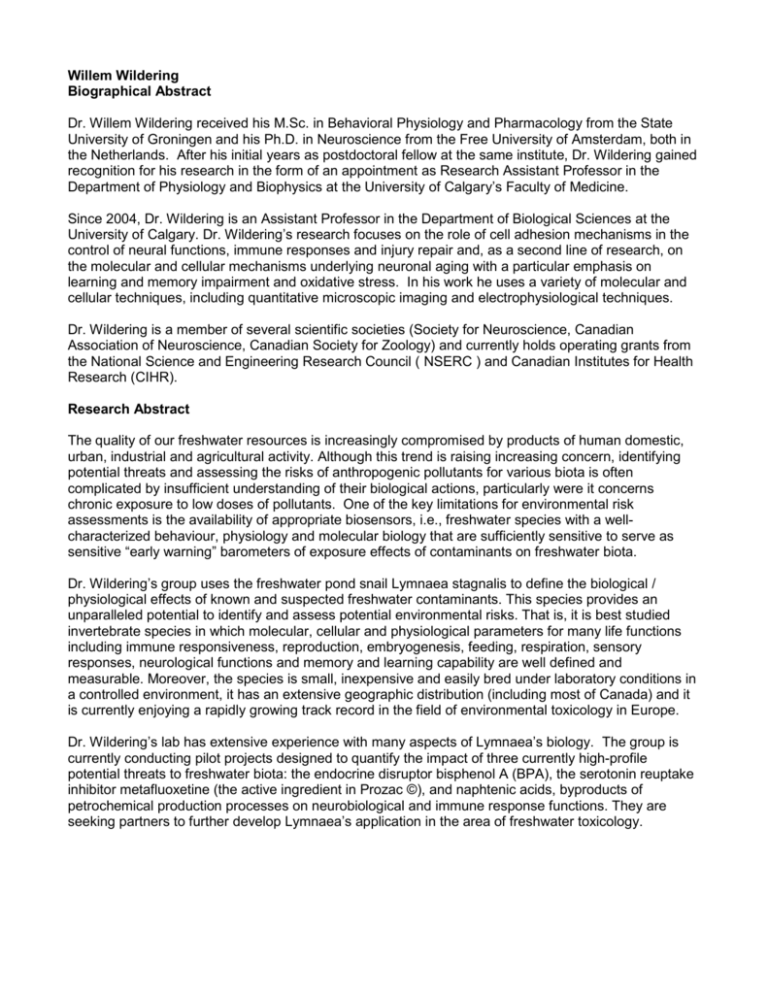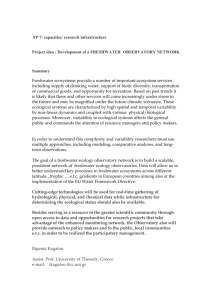Willem Wildering - University of Calgary
advertisement

Willem Wildering Biographical Abstract Dr. Willem Wildering received his M.Sc. in Behavioral Physiology and Pharmacology from the State University of Groningen and his Ph.D. in Neuroscience from the Free University of Amsterdam, both in the Netherlands. After his initial years as postdoctoral fellow at the same institute, Dr. Wildering gained recognition for his research in the form of an appointment as Research Assistant Professor in the Department of Physiology and Biophysics at the University of Calgary’s Faculty of Medicine. Since 2004, Dr. Wildering is an Assistant Professor in the Department of Biological Sciences at the University of Calgary. Dr. Wildering’s research focuses on the role of cell adhesion mechanisms in the control of neural functions, immune responses and injury repair and, as a second line of research, on the molecular and cellular mechanisms underlying neuronal aging with a particular emphasis on learning and memory impairment and oxidative stress. In his work he uses a variety of molecular and cellular techniques, including quantitative microscopic imaging and electrophysiological techniques. Dr. Wildering is a member of several scientific societies (Society for Neuroscience, Canadian Association of Neuroscience, Canadian Society for Zoology) and currently holds operating grants from the National Science and Engineering Research Council ( NSERC ) and Canadian Institutes for Health Research (CIHR). Research Abstract The quality of our freshwater resources is increasingly compromised by products of human domestic, urban, industrial and agricultural activity. Although this trend is raising increasing concern, identifying potential threats and assessing the risks of anthropogenic pollutants for various biota is often complicated by insufficient understanding of their biological actions, particularly were it concerns chronic exposure to low doses of pollutants. One of the key limitations for environmental risk assessments is the availability of appropriate biosensors, i.e., freshwater species with a wellcharacterized behaviour, physiology and molecular biology that are sufficiently sensitive to serve as sensitive “early warning” barometers of exposure effects of contaminants on freshwater biota. Dr. Wildering’s group uses the freshwater pond snail Lymnaea stagnalis to define the biological / physiological effects of known and suspected freshwater contaminants. This species provides an unparalleled potential to identify and assess potential environmental risks. That is, it is best studied invertebrate species in which molecular, cellular and physiological parameters for many life functions including immune responsiveness, reproduction, embryogenesis, feeding, respiration, sensory responses, neurological functions and memory and learning capability are well defined and measurable. Moreover, the species is small, inexpensive and easily bred under laboratory conditions in a controlled environment, it has an extensive geographic distribution (including most of Canada) and it is currently enjoying a rapidly growing track record in the field of environmental toxicology in Europe. Dr. Wildering’s lab has extensive experience with many aspects of Lymnaea’s biology. The group is currently conducting pilot projects designed to quantify the impact of three currently high-profile potential threats to freshwater biota: the endocrine disruptor bisphenol A (BPA), the serotonin reuptake inhibitor metafluoxetine (the active ingredient in Prozac ©), and naphtenic acids, byproducts of petrochemical production processes on neurobiological and immune response functions. They are seeking partners to further develop Lymnaea’s application in the area of freshwater toxicology.







